

Welcome to GoCognitive. Using the new Positive Psychology. Mind and Brain. Specific Conditions. Behaviour + Mindset Tweets... Type A and Type B personality theory. Type A and Type B personality theory describes two contrasting personality types that could either raise or lower, respectively, one's chances of developing coronary heart disease.

There is considerable controversy about the role of these personality types in coronary heart disease and the role of tobacco industry funding of early research in this area. History[edit] Type A personality behavior was first described as a potential risk factor for heart disease in the 1950s by cardiologists Meyer Friedman and Ray Rosenman.
After an eight-and-a-half-year-long study of healthy men between the ages of 35 and 59, Friedman and Rosenman estimated that Type A behavior doubles the risk of coronary heart disease in otherwise healthy individuals.[1] The individuals enrolled in this study were followed well beyond the original time frame of the study. The types[edit] Type A[edit] Type B[edit] The theory describes "Type B" individuals as a contrast to those with Type A personalities. Type D personality. Characteristics[edit] Individuals with a Type D personality have the tendency to experience increased negative emotions across time and situations and tend not to share these emotions with others, because of fear of rejection or disapproval.
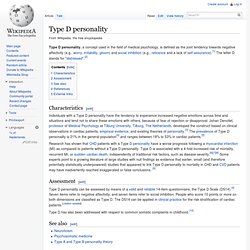
Johan Denollet, professor of Medical Psychology at Tilburg University, Tilburg, The Netherlands, developed the construct based on clinical observations in cardiac patients, empirical evidence, and existing theories of personality.[3] The prevalence of Type D personality is 21% in the general population[4] and ranges between 18% to 53% in cardiac patients.[5] Research has shown that CHD patients with a Type D personality have a worse prognosis following a myocardial infarction (MI) as compared to patients without a Type D personality.
Assessment[edit] Type D has also been addressed with respect to common somatic complaints in childhood.[10] Social intelligence. Social intelligence is the capacity to effectively negotiate complex social relationships and environments.[1] Psychologist Nicholas Humphrey believes that it is social intelligence, rather than quantitative intelligence, that defines humans.
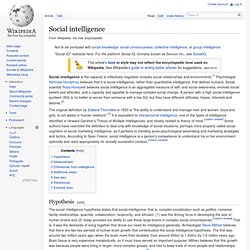
Myers-Briggs Type Indicator. Model of personality types A chart with descriptions of each Myers–Briggs personality type and the four dichotomies central to the theory The Myers–Briggs Type Indicator (MBTI) is an introspective self-report questionnaire indicating differing psychological preferences in how people perceive the world and make decisions.[1][2][3] The original versions of the MBTI were constructed by two Americans, Katharine Cook Briggs and her daughter Isabel Briggs Myers.[4] The MBTI is based on the conceptual theory proposed by Swiss psychiatrist Carl Jung,[5] who had speculated that people experience the world using four principal psychological functions – sensation, intuition, feeling, and thinking – and that one of these four functions is dominant for a person most of the time.[6] The four categories are Introversion/Extraversion, Sensing/Intuition, Thinking/Feeling, Judging/Perception.
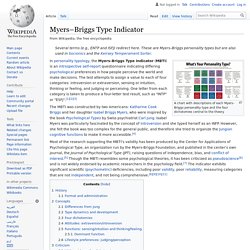
Each person is said to have one preferred quality from each category, producing 16 unique types. History[edit] MBTI online test. INTJ. According to Myers-Briggs the INTJ represents "The Mastermind.
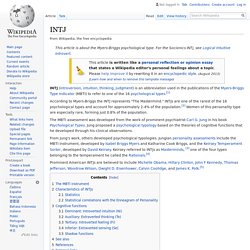
" INTJs are one of the rarest of the 16 psychological types and account for approximately 2-4% of the population.[2] Women of this personality type are especially rare, forming just 0.8% of the population. The MBTI assessment was developed from the work of prominent psychiatrist Carl G. Rational temperament.
Description[edit] As the knowledge-seeking temperament, Rationals trust reason implicitly.

They rely on objective observations and factual analysis in any given situation. They seek a logical argument as a basis for action. As strategists, Rationals strive to gain as much information as possible, applying what they learn to develop long-term plans and the steps for achieving them. They are characterized by a tough-minded personal style, tending to pursue either power or understanding. INTJ Relationships. INTJs believe in constant growth in relationships, and strive for independence for themselves and their mates.
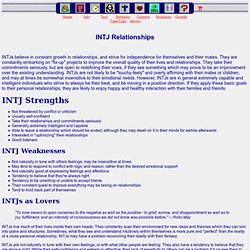
They are constantly embarking on "fix-up" projects to improve the overall quality of their lives and relationships. They take their commitments seriously, but are open to redefining their vows, if they see something which may prove to be an improvement over the existing understanding. Personality Types Under Stress. Personality Types Under Stress - INTP, INTJ, INFP, INFJ INTPs lack follow-through and this can isolate their ideas from practical examination.
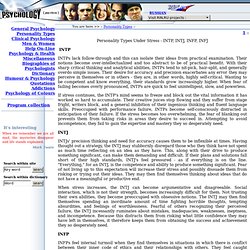
Their notions become over-intellectualized and too abstract to be of practical benefit. With their sharp critical thinking and analytical abilities, INTPs tend to nit-pick, hair-split, and generally overdo simple issues. 10 Myths About Introverts. Discovering EGO. Enneagram Test. These two online Enneagram tests help you to determine which personality type you are.

Your wing will also be indicated. Some suggestions on how to take the tests to get the most accurate results can be found below. Classical enneagram test. Mental Health-Guide. 6 Unique Ways to Sustain a High-Performance Mentality. 28 Ways to Stop Complicating Your Life. 40 Lessons for Finding Strength in Hard Times. Post written by: Marc Chernoff Sometimes you have to die a little on the inside first in order to be reborn and rise again as a stronger, smarter version of yourself.

Nobody gets through life without losing someone they love, someone they need, or something they thought was meant to be. But it is these losses that make us stronger and eventually move us toward future opportunities for growth and happiness. Over the past five years Angel and I have dealt with several hardships, including the sudden death of a sibling, the loss of a best friend to illness, betrayal from a business partner, and an unexpected (breadwinning) employment layoff. These experiences were brutal. Here are some lessons we’ve learned along the way: You are not what happened to you in the past. – No matter how chaotic the past has been, the future is a clean, fresh, wide open slate.
Post-Traumatic Stress Disorder (PTSD) What is post-traumatic stress disorder (PTSD)? Post-traumatic stress disorder (PTSD) can develop following a traumatic event that threatens your safety or makes you feel helpless. Most people associate PTSD with battle-scarred soldiers—and military combat is the most common cause in men—but any overwhelming life experience can trigger PTSD, especially if the event feels unpredictable and uncontrollable. Post-traumatic stress disorder (PTSD) can affect those who personally experience the catastrophe, those who witness it, and those who pick up the pieces afterwards, including emergency workers and law enforcement officers.
It can even occur in the friends or family members of those who went through the actual trauma. PTSD develops differently from person to person. Traumatic events that can lead to PTSD include: Managing Adbandonment Depession. Here is a map of the layering of defensive reactions to the underlying feelings of abandonment typically found in Complex PTSD. This territory is best viewed through unwinding the dynamics of emotional flashbacks. Flashbacks are at the deepest level painful layers of reactions - physiological, emotional, cognitive, and behavioral - to the reemerging despair of the childhood abandonment depression.
One very common flashback-scenario occurs as follows: Internal or external perceptions of possible abandonment trigger fear and shame, which then activates panicky Inner Critic cognitions, which in turn launches an adrenalized fight, flight, freeze or fawn trauma response (subsequently referred to as the 4F's). The 4F's correlate respectively with narcissistic, obsessive-compulsive, dissociative or codependent defensive reactions. Here is an example of the layered processes of an emotional flashback. National Center for PTSD Home.